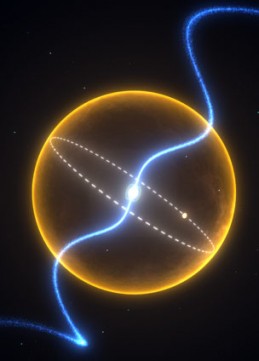A planet made of diamond
August 29, 2011

The pulsar at the center is orbited by an object that is about the mass of Jupiter and composed primarily of carbon, effectively a massive diamond. The orbit, represented by the dashed line, would easily fit inside our Sun, represented by the yellow surface. The blue lines represent the radio signal from the pulsar, which spins around 175 times every second (credit: Swinburne Astronomy Productions)
A once-massive star has been transformed into a small planet made of diamond, researchers led by Swinburne University of Technology in Melbourne have found.
The researchers first detected a pulsar using the Parkes radio telescope of the Australian Commonwealth Scientific and Industrial Research Organisation (CSIRO).
The newly discovered pulsar, known as PSR J1719–1438, produced pulses that were systematically modulated. The astronomers concluded that this was due to the gravitational pull of a small companion planet, orbiting the pulsar in a binary system.
They think it is the companion that, in its star form, transforms an old, dead pulsar into a millisecond pulsar by transferring matter and spinning it up to a very high speed. The result is a fast-spinning millisecond pulsar with a shrunken companion — likely a white dwarf.
“We know of a few other systems, called ultra-compact low-mass X-ray binaries, that are likely to be evolving according to the scenario above and may likely represent the progenitors of a pulsar like J1719-1438,” said team member Dr Andrea Possenti, Director at INAF-Osservatorio Astronomico di Cagliari.
But pulsar J1719-1438 and its companion are so close together that the companion can only be a very stripped-down white dwarf, one that has lost its outer layers and over 99.9 per cent of its original mass.
“This remnant is likely to be largely carbon and oxygen, because a star made of lighter elements like hydrogen and helium would be too big to fit the measured orbiting times,” said Dr Michael Keith (CSIRO), one of the research team members.
The density means that this material is certain to be crystalline: that is, a large part of the star may be similar to a diamond, the astronomers said.
Ref.: M. Bailes, et al., Transformation of a Star into a Planet in a Millisecond Pulsar Binary, Science, 2011; [DOI: 10.1126/science.1208890]